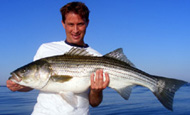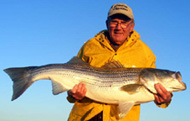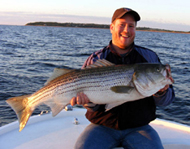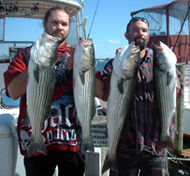|
|
|||
|
Fishing The North ReefLearn how to fish the Reef at Block Island's North end.By Chris Bell and Earl Bell.The rip at Block Island's north end can be a very productive fishing ground if you know when to fish it and what to use. I used to go there and catch very little to nothing, never really thinking of it as a productive place until I learned how to fish it. Even after all these years I am still learning how to fish it. There are a variety of ways to fish the rip, but in each case conditions that work best for that type of fishing should be followed. Pay attention to the tide and time of day, and see if you detect a pattern which repeats itself. This is how you'll become better at fishing any area. Trolling. I find that the best trolling occurs when the tide is incoming and you arrive around 6:30-7:00am with the tide coming in for about an hour already. Then you can troll wireline outfits with umbrellas or parachutes and catch bass and bluefish for about 3 to 4 hours until the tide begins to slow down. I always troll against the current from 70 feet deep to go over the top of the hump at 40 feet, going very slow by the time I reach the 40 foot mark. Every time I'll hook up under these conditions. If you don't hook up, try letting out more line. The current can get very strong and if your not near the bottom nothing will happen. Drifting. Drifting is another very productive method, and works best on the outgoing tide. Best to arrive around 6:30 with the tide having been outgoing for at least an hour. You can drift over the middle hump, which is about 12' deep over the top. Use soft plastics like the Storm pearl 6" swim shad, cast them out, let them sink near the bottom, and use a jigging retrieve. Be ready, when you lift the rod, the fish will be there. If you feel a hit and don't hook the fish, work it very slowly with lots of short jigs, as if it were an injured fish. This will bring more strikes. Drifting can be used at any point along the length of the sand bar. Different rigs can be used, even live bait, like eels. |
|
|
|
Topwater plugs are another good option, but they only work with a running tide and during overcast or foggy days, when the fish can't get a good look at the plug. They also work in the dim light of dawn, but it isn't very safe to be crossing over to the island in the dark unless you are a very good navigator and there is radar on the vessel. It isn't fun to end up on the bow of a barge as it is being towed east or west by a big tugboat. Topwaters are worked when near the rough water, after you drift out of range you'll have to go around for another pass. Another useful technique when drifting the Rip is diamond jigging. For this to be successful, you need to be in deeper water usually near the outer rise of the sandbar where it comes up to 48 feet or so. Also, this works best when the tide is running slowly, as it gives the fish a chance to see and hear the diamond jig. A minimum depth for diamond jigging would be 40 feet. Best conditions are early morning with the tide running slowly. Keep your eyes open for any surface activity. If you see feeding fish, position the boat updrift and let the current bring you into casting range. Then cast in to the fish and work your offering. Try to match whatever they may be feeding on. It's not always easy to use your fish finder at the North rip. The
current can sweep many things past the bottom, many of which may show up
as fish icons on your depth finder. So marking a lot of fish doesn't
always mean that fish are there. During a "spring" tide (the largest
tides that occur when the sun and the moon are on the same side of the
earth) the current can get very strong. When the current gets near its
maximum, it's not often good fishing on the rip because the current
makes noise as it travels over the bottom structure at those speeds.
This makes it harder for the fish to find your lure, especially as you
get into deeper water. Best to fish soon after the high or low water
mark on these days and avoid the mid-tide time when the current is
screaming. Article by Chris and Earl Bell. Go to the Adventure rhode island striper fishing charters website. |
|||




